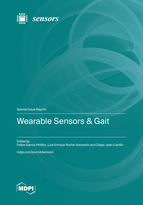Wearable Sensors & Gait
A special issue of Sensors (ISSN 1424-8220). This special issue belongs to the section "Wearables".
Deadline for manuscript submissions: closed (31 January 2022) | Viewed by 54253
Special Issue Editors
Interests: physiology; training; biomechanics
Special Issues, Collections and Topics in MDPI journals
Interests: sport biomechanics; sport technology; gait biomechanics; running biomechanics
Special Issues, Collections and Topics in MDPI journals
Interests: port biomechanics; endurance; performance; running; sport technology; training
Special Issues, Collections and Topics in MDPI journals
Special Issue Information
Dear Colleagues,
Gait analysis has been traditionally conducted in laboratory settings and thereby has requested specific conditions and expensive equipment. The emergence of wearable sensors solves the lack of ecology for these measurements and offers a more economical and easy to use option to perform gait analysis. Lately, wearable sensors have allowed the quantification of performance and workload by providing mechanical and physiological parameters and their popularity has grown exponentially. In this context, more and more wearable sensors are commercially available and, when applied to gait analysis (either walking or running), these devices are able to provide both kinetic and kinematic variables improving consequently the feasibility and testing time of such assessments and, therefore, becoming a real alternative for clinicians, researchers and sport practitioners.
The incremental growth in big data, cloud computing and artificial intelligent make these sensors suitable to connect gait biomechanics with real life and real time analysis. All these benefits broaden the possibilities, among others, to provide real-time biofeedback while walking and running, or to integrate sensors with cloud platforms or mobile apps to improve health and/or performance.
This Special Issue encourages authors to submit their research and contributions about the use and application of wearable sensors for gait assessment and analysis.
The main topics for this issue include, but not limited to:
- Validity analysis of novel wearable sensors for human locomotion.
- Reliability analysis of wearable sensor.
- New applications and uses of metrics provided by wearable sensors in training, competition and injury management settings.
- Novel technologies applied to gait analysis.
- State of the art for wearable devices.
-Algorithms, integrations with other platforms or software, signal processing, and bigdata obtained by wearable sensors.
Prof. Felipe García-Pinillos
Prof. Luis Enrique Roche-Seruendo
Dr. Diego Jaén-Carrillo
Guest Editors
Manuscript Submission Information
Manuscripts should be submitted online at www.mdpi.com by registering and logging in to this website. Once you are registered, click here to go to the submission form. Manuscripts can be submitted until the deadline. All submissions that pass pre-check are peer-reviewed. Accepted papers will be published continuously in the journal (as soon as accepted) and will be listed together on the special issue website. Research articles, review articles as well as short communications are invited. For planned papers, a title and short abstract (about 100 words) can be sent to the Editorial Office for announcement on this website.
Submitted manuscripts should not have been published previously, nor be under consideration for publication elsewhere (except conference proceedings papers). All manuscripts are thoroughly refereed through a single-blind peer-review process. A guide for authors and other relevant information for submission of manuscripts is available on the Instructions for Authors page. Sensors is an international peer-reviewed open access semimonthly journal published by MDPI.
Please visit the Instructions for Authors page before submitting a manuscript. The Article Processing Charge (APC) for publication in this open access journal is 2600 CHF (Swiss Francs). Submitted papers should be well formatted and use good English. Authors may use MDPI's English editing service prior to publication or during author revisions.









